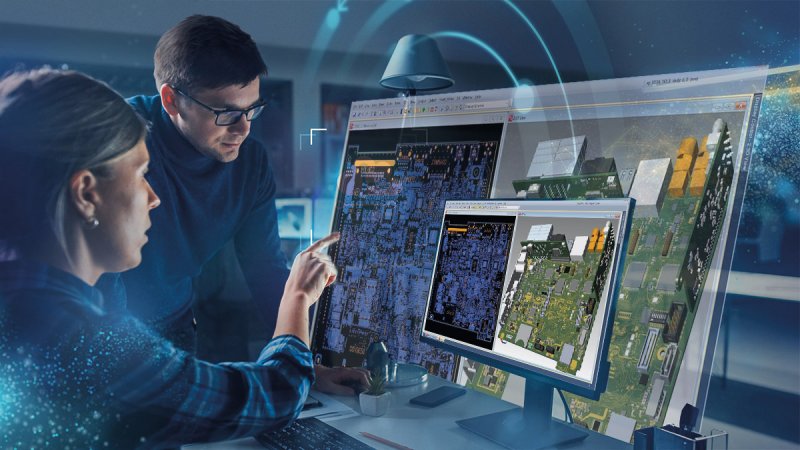
The journey from a brilliant idea to a tangible, market-ready electronic product is fraught with challenges. It requires not just ingenuity, but precision, efficiency, and the ability to iterate rapidly. At the heart of nearly every modern electronic device lies the Printed Circuit Board (PCB), the foundational platform that connects components and makes the magic happen.
For tech inventors, whether they are bootstrapping a startup in a garage, leading an R&D department, or pursuing an ambitious personal project, the ability to design and validate PCBs efficiently is paramount. This is where PCB design software emerges not just as a tool, but as an indispensable partner, transforming abstract concepts into physical realities.
Bridging the Chasm: From Concept to Circuit
Before the advent of sophisticated PCB design software, engineers relied on manual schematics, breadboard prototypes, and tedious hand-drawn layouts. This approach was slow, error-prone, and incredibly difficult to scale or modify. For the modern tech inventor, operating in a fast-paced environment where time-to-market is critical, such methods are simply untenable. PCB design software fundamentally bridges this chasm by offering an integrated digital environment that supports every stage of the design process, making it faster, more accurate, and significantly more collaborative.
1. Empowering Schematic Capture: The Blueprint of Functionality
The first step in any electronic design is creating a schematic – a graphical representation of the circuit’s components and their interconnections. PCB design software provides intuitive tools for schematic capture that offer several profound advantages for inventors:
- Clarity and Organization: Complex circuits can be organized into manageable blocks, making them easier to understand, debug, and modify. Hierarchical design allows inventors to reuse common sub-circuits, saving time and ensuring consistency.
- Vast Component Libraries: Most professional software packages come with extensive libraries of electronic components, from resistors and capacitors to microcontrollers and advanced sensors. If a component isn't available, symbols and footprints can be easily created. This dramatically speeds up the design process by eliminating the need to manually draw every part.
- Error Detection at Conception: Software can perform basic electrical rule checks (ERC) on the schematic, identifying common errors like unconnected pins, short circuits, or incorrect power connections before they translate into a physical layout. Catching errors early saves immense time and cost.
- Automated Netlist Generation: Once the schematic is sound, the software automatically generates a "netlist" – a text file detailing all components and their connections. This netlist is the crucial link that translates the logical schematic into the physical PCB layout, ensuring that no connection is missed or misplaced.
2. Precision Layout and Routing: Crafting the Physical Board
With the schematic defining the circuit's logic, the next vital step is the physical layout of components and the routing of traces on the PCB. This stage is where the magic of transforming a flat idea into a three-dimensional product truly begins.
- Visualizing Component Placement: Software allows inventors to virtually place components on the board, optimizing for factors like signal integrity, thermal dissipation, mechanical fit within an enclosure, and ease of assembly. This visual feedback is invaluable for refining the physical form factor.
- Efficient Routing: Routing involves drawing the copper traces that electrically connect component pins as defined by the netlist. Modern PCB design tools offer:
- Manual Routing: For critical high-speed signals or sensitive analog paths where precise control is paramount.
- Interactive Routing: Guides the user with real-time feedback on clearances and design rules.
- Automatic Routing: Capable of routing entire boards or complex sections quickly, especially useful for less sensitive signals or initial iterations.
- Multi-Layer Design: As electronic devices become more compact and complex, multi-layer PCBs (2, 4, 6, or even more layers) are common. Software simplifies the management of these layers, allowing inventors to route signals efficiently without compromising space or signal integrity.
- Ground Planes and Power Integrity: Powerful features enable the creation of robust ground and power planes, crucial for minimizing noise, ensuring stable power delivery, and enhancing the overall performance and reliability of the circuit – factors vital for any professional product.
3. Simulation and Analysis: "Fail Fast, Fail Cheap"
One of the most transformative aspects of modern PCB design software is its integration with powerful simulation and analysis tools. For inventors, this means the ability to test and refine their designs virtually, drastically reducing the need for costly and time-consuming physical prototypes.
- Signal Integrity (SI) Analysis: Essential for high-speed designs, SI analysis predicts issues like reflections, crosstalk, and electromagnetic interference (EMI) that can degrade signal quality. Inventors can identify and mitigate these problems in the design phase, avoiding frustrating and expensive post-prototype debugging.
- Power Integrity (PI) Analysis: Ensures that all components receive stable and sufficient power. It helps identify voltage drops, current density issues, and potential hotspots, leading to a more reliable and efficient power delivery network.
- Thermal Analysis: Critical for devices that generate heat. Software can simulate heat distribution on the board, helping inventors optimize component placement and consider cooling solutions early on.
- SPICE Simulation: Many packages integrate with or include SPICE (Simulation Program with Integrated Circuit Emphasis) engines, allowing inventors to simulate the behavior of analog and mixed-signal circuits, predict output waveforms, and optimize component values without soldering a single component.
By leveraging these simulation capabilities, inventors can "fail fast and fail cheap" – quickly identify design flaws and iterate on solutions in the digital realm before committing to expensive physical manufacturing.
4. Design Rule Checking (DRC) and Design for Manufacturability (DFM): Ensuring Production Ready Boards
Even a perfectly functioning circuit on paper can be unmanufacturable or excessively expensive if not designed with production in mind. PCB design software incorporates robust DRC and DFM features that are lifesavers for inventors aiming for mass production.
- Automated Design Rule Checking (DRC): This feature automatically flags violations of pre-defined rules, such as minimum trace width, copper-to-copper clearances, drill sizes, solder mask clearances, and more. DRC catches errors that prevent a board from being fabricated correctly or reliably.
- Design for Manufacturability (DFM): DFM checks go a step further, ensuring the design is optimized for cost-effective manufacturing and assembly. This includes checking for issues like insufficient pad sizes, incorrect component spacing for pick-and-place machines, or potential solder bridge issues.
- Generating Manufacturing Outputs: The software generates industry-standard output files (Gerber files, drill files, Bill of Materials/BOM, pick-and-place files) that are directly sent to PCB fabricators and assemblers. This standardization streamlines the production process, reducing communication errors and accelerating time-to-market.
For inventors, these features mean significantly reduced risk of costly re-spins (having to re-design and re-manufacture a board due to errors), lower manufacturing costs, and a smoother transition from prototype to production.
5. Collaboration and Version Control: The Team Advantage
Innovation often thrives in collaborative environments. Modern PCB design software is increasingly built with features that facilitate teamwork, which is invaluable for inventors working with distributed teams or external consultants.
- Cloud-Based Platforms: Many tools offer cloud integration, allowing multiple team members to access and work on the same project files from different locations.
- Version Control: Like software development, PCB design benefits immensely from version control. Inventors can track changes, revert to previous versions, and understand who made what modifications, essential for managing complex projects and avoiding conflicts.
- Integrated ECAD/MCAD: The mechanical design of an enclosure must perfectly fit the PCB. Some advanced software offers integrated ECAD (Electronic Computer-Aided Design) with MCAD (Mechanical Computer-Aided Design) tools, allowing inventors to visualize the board within its mechanical housing, ensuring precise fit and preventing costly late-stage surprises.
6. Cost and Time Efficiency: Accelerating the Innovation Cycle
Ultimately, the most compelling advantage of PCB design software for tech inventors is the significant gains in cost and time efficiency.
- Reduced Prototyping: By identifying and correcting errors digitally, inventors can drastically reduce the number of physical prototype iterations, saving on fabrication costs, component purchases, and engineering time.
- Faster Iteration: The digital environment allows for rapid modifications and testing, enabling inventors to iterate on their designs at a pace impossible with manual methods.
- Optimized Manufacturing: DFM features lead to boards that are cheaper and faster to produce, directly impacting the overall product cost and time to market.
- Focus on Innovation: By automating tedious and error-prone tasks, the software frees up inventors to focus their valuable time and energy on the core innovative aspects of their product, rather than getting bogged down in minutiae.
Conclusion: The Indispensable Partner in Tech Innovation
For the tech inventor, the journey from a nascent idea to a market-disrupting product is a marathon, not a sprint. PCB design software stands as an indispensable partner in this race, offering a comprehensive suite of tools that address the most critical challenges of electronic development. From the clarity of schematic capture to the precision of layout, the foresight of simulation, and the pragmatism of DFM, these tools empower inventors to design with confidence, iterate with agility, and bring their groundbreaking ideas to life with unparalleled efficiency. In an era where technological innovation is the driving force of progress, PCB design software is not just a facilitator; it is the very architect of the future.







0 Comments
Post Comment
You will need to Login or Register to comment on this post!